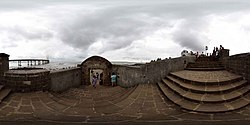Castella de Aguada
| Castella de Aguada | |
|---|---|
 Bandra Fort | |
| General information | |
| Type | Fort |
| Location | Bandra,Mumbai |
| Coordinates | 19°02′30″N72°49′07″E/ 19.041770°N 72.818580°E |
| Elevation | 13 m (43 ft) |
| Completed | 1640 |
| Client | Portuguese |
| Owner | Government of Maharashtra |
Castella de Aguada(corruption ofCastelo da Aguada,Portuguesefor "Fort of the Waterpoint" ), also known as theBandra Fort,is a fort located inBandra,Mumbai."Castella" is a misspelling for Portuguese "Castelo" (castle), although it seems its Portuguese builders actually called it Forte de Bandorá (or Bandra Fort). It is located atLand's EndinBandra.It was built by the Portuguese in 1640 as a watchtower overlookingMahim Bay,theArabian Seaand the southern island ofMahim.[1]The strategic value of the fort was enhanced in 1661 after the Portuguese ceded theseven islands of Bombaythat lay to the immediate south of Bandra to theEnglish.[2]The name indicates its origin as a place where fresh water was available in the form of a fountain ( "Aguada" ) for Portuguese ships cruising the coasts in the initial period of Portuguese presence. The fort lies over several levels, from sea level to an altitude of 24 metres (79 ft).[1]Castella de Aguada has been featured in several Hindi films, such asDil Chahta HaiandBuddha Mil Gaya.[3]
History
[edit]The Portuguese, who had established a base in the area in 1534 after defeatingBahadur Shah of Gujarat,built several sea forts along the western Indian coastline. Castella de Aguada was one such strategically located fort, overlooking the Mahim Bay to the south, the Arabian Sea to the west, the islands of Worli to the south and the town of Mahim to the south west. The fort also guarded the northern sea route intoMumbai Harbour.This sea route, a large estuary, was later reclaimed from the sea in the nineteenth century. During the Portuguese rule, it was armed with seven cannons and other smaller guns as defence.[4]A freshwater spring in the vicinity supplied potable water to passing ships, thus lending the fort its name.[1]
After the decline of the Portuguese in the early 18th century, the Marathas became the largest threat toBritish possessions.Sensing an impending Portuguese defeat, the British partially demolished the fort as a precautionary measure. The demolition would obviate the possibility of the fort being captured by the Marathas, with the possibility of it being used as a forward military base to attack British Bombay.[5]
In 1739 the island was invaded by theMarathas;it was ruled by them until 1774 when the British gained possession of the area during theFirst Anglo-Maratha War.In 1830, the British donated large parts ofSalsette Island,includingLand's End(Click to view the Photosphere), toByramjee Jeejeebhoy,aParsiphilanthropist. Jeejeeboy then established his residence on the hill where the fort is located, and the cape was renamed Byramjee Jeejeebhoy Point.[6]
Conservation
[edit]In 2003, a conservation program was started by Bandra Band Stand Residents’ Trust to save the fort. It was spearheaded by a local Member of Parliament (MP),Shabana Azmi,who funded part of the effort from her allotted funds. The brick arch of one of the gateways on the verge of collapse, and the foundation masonry of the fort wall that was in danger of tidal erosion were repaired. The nearby Taj Land's End hotel is responsible for maintenance of the fort, having inherited it from the previous owners.[1]

The fort is owned by theArchaeological Survey of India(ASI). Included in the fort makeover are the preservation of the natural rock formations, providing pathways, and the creation of an amphitheatre. The architect for the makeover was P.K. Das, who had earlier redesigned theCarter Roadarea.[6]
See also
[edit]References
[edit]- ^abcdBall, Iain (19 March 2003)."Local 'army' offers to protect Mumbai's 'Castella'".Mumbai Newsline.Express Group.Archived fromthe originalon 24 July 2006.Retrieved16 September2008.
- ^"Revisiting the forgotten forts – Part I- Castella de Aguada: History of the grand ruins in Bandra most Mumbaikars are oblivious to".The Indian Express.16 November 2015.Retrieved1 August2021.
- ^Lambah, Abha Narain (4 February 2008)."Heritage is also Bollywood's preserve".Mumbai Newsline.Express Group.Retrieved29 December2008.[dead link]
- ^D'Cunha, Jose Gerson (1900). "IV The Portuguese Period".The Origins of Bombay(3 ed.). Bombay: Asian Educational Services. p. 212.ISBN81-206-0815-1.Retrieved29 December2008.
- ^Marpakwar, Prafulla (26 November 2006)."Govt Will Remain Owner Of The State's Heritage Sites But Corporate Caretaker, Too, Stands To Gain From Tie-Up".Times of India.Times Group.Archived fromthe originalon 17 July 2011.Retrieved29 December2008.
- ^ab"Bandra to get back a chunk of its past glory".Times of India.Times Group.4 August 2002.Retrieved16 September2008.

